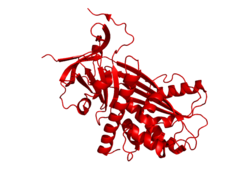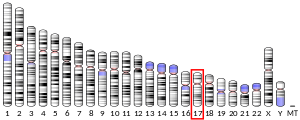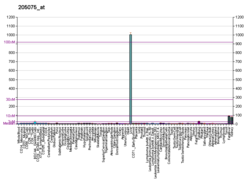Alpha 2-antiplasmine
L'alpha 2-antiplasmine est une protéine inhibitrice de la plasmine, et donc de la fibrinolyse. Son gène est SERPINF2 porté par le chromosome 17 humain.
Elle a été découverte en 1976[5].
Rôle
modifierFormée de 464 acides aminés, elle est clivée par une protéase (APCE) en un protéine de 452 acides aminés plus actives[6].
Il s'agit du principal inhibiteur de la plasmine[7]. Elle se lie au facteur XIII et à la fibrine, permettant la stabilisation du thrombus[8].
Médecine
modifierSon taux s'élève dans le cas des maladies thromboemboliques survenant malgré une anticoagulation prophylactique[9].
Un déficit congénital en cette protéine induit un syndrome hémorragique[5].
Son inhibition pourrait constituer une voie thérapeutique : elle activerait la fibrinolyse sans dégrader le fibrinogène et avec un moindre risque de saignements[10]. Cette inhibition par des anticorps monoclonaux ou par de petits peptides sont en cours de test dans le traitement des thromboses[11].
Notes et références
modifier- ENSG00000276838 GRCh38: Ensembl release 89: ENSG00000167711, ENSG00000276838 - Ensembl, May 2017
- GRCm38: Ensembl release 89: ENSMUSG00000038224 - Ensembl, May 2017
- « Publications PubMed pour l'Homme », sur National Center for Biotechnology Information, U.S. National Library of Medicine
- « Publications PubMed pour la Souris », sur National Center for Biotechnology Information, U.S. National Library of Medicine
- Aoki N, Discovery of alpha2-plasmin inhibitor and its congenital deficiency, J Thromb Haemost, 2005;3:623–631
- Lee KN, Jackson KW, Christiansen VJ, Chung KH, McKee PA, A novel plasma proteinase potentiates alpha2-antiplasmin inhibition of fibrin digestion, Blood, 2004;103:3783–3788
- Leebeek FW, Kluft C, Knot EA, Los P, Cohen AF, Six AJ, Plasmin inhibitors in the prevention of systemic effects during thrombolytic therapy: specific role of the plasminogen-binding form of alpha 2-antiplasmin, J Am Coll Cardiol, 1990;15:1212–1220
- Mitchell JL, Lionikiene AS, Fraser SR, Whyte CS, Booth NA, Mutch NJ, Functional factor XIII-A is exposed on the stimulated platelet surface, Blood, 2014;124:3982–3990
- Wojcik M, Zareba L, Undas A. Prothrombotic fibrin clot properties are associated with post-discharge venous thromboembolism in acutely ill medical patients, Thromb Res, 2019;182:141–149
- Singh S, Houng A, Reed GL, Releasing the brakes on the fibrinolytic system in pulmonary emboli: unique effects of plasminogen activation and α2-antiplasmin inactivation, Circulation, 2017;135:1011−1020
- Singh S, Kumar P, Padwad YS, Jaffer FA, Reed GL, Targeting fibrinolytic inhibition for venous thromboembolism treatment: Overview of an emerging therapeutic approach, Circulation, 2024;150!884-898





